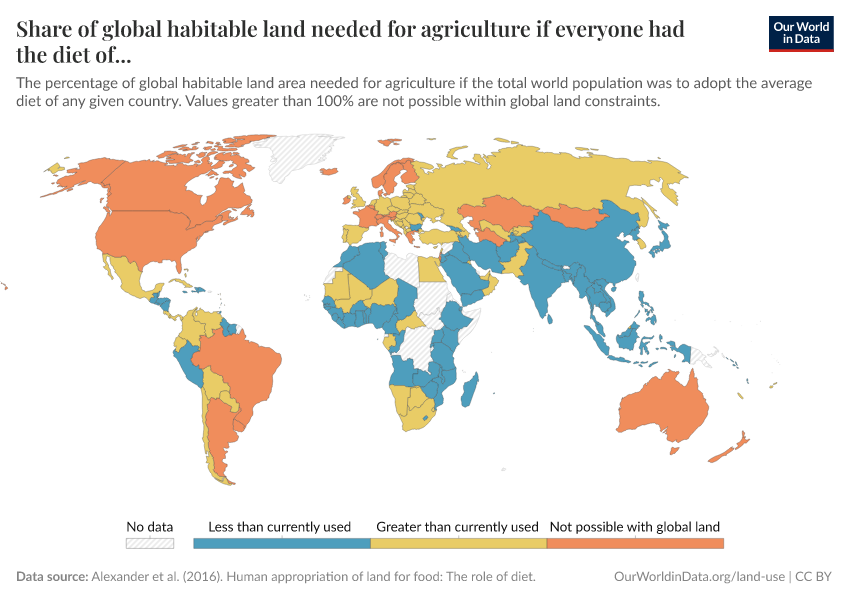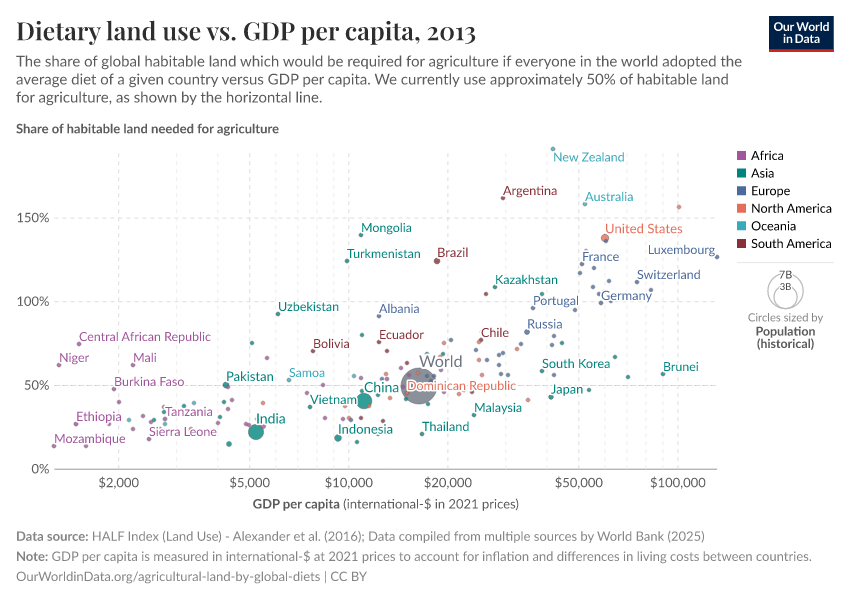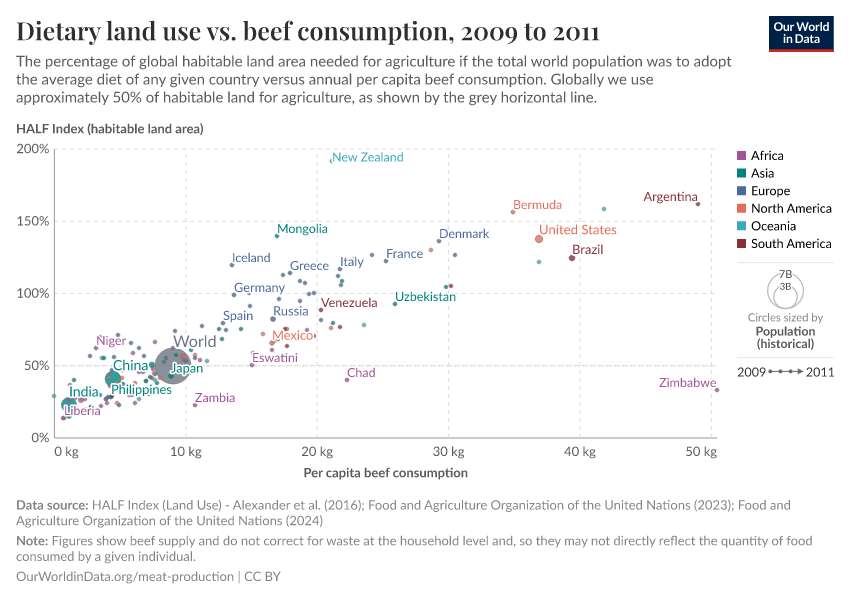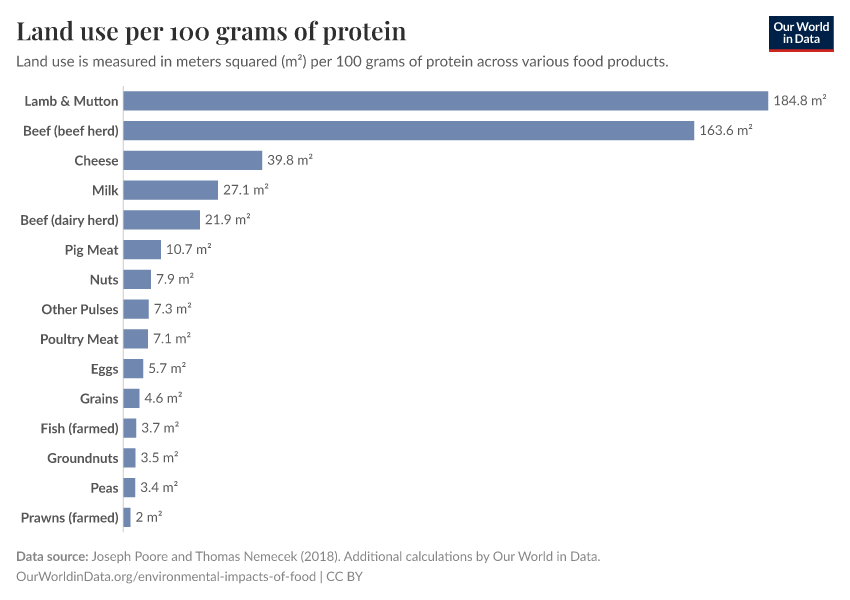How much of the world’s land would we need in order to feed the global population with the average diet of a given country?
Livestock takes up nearly 80% of global agricultural land, yet produces less than 20% of the world's supply of calories (as shown in the visualization). This means that what we eat is more important than how much we eat in determining the amount of land required to produce our food. As we get richer, our diets tend to diversify and per capita meat consumption rises; economic development unfortunately exerts an increasing impact on land resources. If we want per capita meat consumption to be able to rise sustainably at lower incomes, per capita meat consumption at high incomes will have to decrease.
This raises an interesting question: if we were to reach a level of sustainable dietary equitability at a global level, what would our diet have to look like? Alexander et al. (2016) attempted to answer this question using a thought experiment, termed the 'HALF index' (short for 'Human Appropriation of Land for Food').1
The HALF index asks and answers the hypothetical question: if everyone in the world adopted the average diet of country 'x', what percentage of the global land area would we need for agriculture?
Alexander et al. (2016) calculate this index based on the combination of UN Food and Agricultural Organization (FAO) national consumption patterns and global average yield and land use intensities for different food commodities. This data is based on FAO data from 2011—the latest year available at the time of the paper's publication. By combining metrics of dietary composition (for example, the average per capita consumption of beef in the United Kingdom) and the land intensity of beef production (the amount of land required to produce a kilogram of beef based on average global figures), the authors calculated the average amount of land required to supply the diet of an individual in any given country. Note that this measure does not include fish and other seafood products. By multiplying this land requirement per person by the global population, we can make an estimate of the total area (and therefore the share of land area) which would be required if everyone in the world adopted the dietary habits of any given country. The authors define this measure (the share of land area required for agriculture if everyone adopted the diet of country 'x'), the HALF index.
We have utilized the figures from the HALF index as reported in this paper for the visualizations in this article, with one notable change. Whilst Alexander et al. report this index as the percentage of total global land area, we find it easier to interpret these figures as the percentage of total global habitable land area. With our change, an index value of 100 percent indicates that the global adoption of a given diet would be physically achievable if we used all habitable land area for agriculture and values greater than 100 percent are not viable within global land constraints. We have therefore adapted HALF index figures for habitable land area based on the assumption that 71 percent of global total land area is habitable, as shown in the chart.
Land requirements by national diets
Today, the world population uses approximately 50 percent of total habitable land for agriculture.
How much of our habitable land would we need if the global population were to adopt the average diet of any given country? The results are presented in the map shown here. We have color-coded the map based on our current agricultural land requirements and our physical land constraints as follows:
- Countries shown in blue have an average diet which, if adopted globally, would result in less land use for agriculture than current levels (i.e. their HALF index is less than 50 percent).
- Countries shown in yellow have an average diet which, if adopted globally, would require an expansion of agricultural land from our current allocation, but would be physically viable within global land constraints (i.e. their HALF index is between 50 and 100 percent).
- Those shown in orange have dietary requirements which would not be feasible at a global scale, even if we converted all habitable land to agriculture (i.e. their HALF index is greater than 100 percent).
You can explore the exact percentage values by hovering over any country in the interactive map.
Overall, there is a 14-fold difference in land requirements across national diets. If we were to achieve equitable diets using less land than we currently do, we can see that the world would have to converge towards the dietary compositions of countries across South Asia, Sub-Saharan Africa, and some Latin American countries (i.e. the countries shown in green). The largest sub-set of countries fall within the middle bracket: global adoption of such diets would require agricultural expansion, but may be physically viable within habitable land resources. However, there are also a number of countries which fall into the orange category: it would be ecologically impossible for everyone to eat the diet in North America, Brazil, Argentina, Australia, New Zealand, and several countries across Europe.
If everyone were to adopt the average diet of the United States, we would need to convert all of our habitable land to agriculture, and we'd still be 38 percent short. For a New Zealand diet, we'd need almost twice as much habitable land as we have.
The link between dietary pressures and prosperity
Why are there such variations in dietary land requirements across the world? In the chart here we have plotted each country's HALF index (as represented in the map above) on the y-axis, against its gross domestic product (GDP) per capita, on the x-axis. Overall we see that richer populations have larger dietary land requirements. Also shown on this graph is the proportion of land we currently use for agricultural production, plotted as a grey horizontal line at 50 percent. The majority of countries which lie below this line are in Africa (in blue) and Asia (in red), and most have per capita incomes of less than $10,000 per year.
The implication is that there is an important trade-off between environmental impact and nutrition: for a variety of ecological reasons, including biodiversity and climatic change, we want to reduce our agricultural land pressures; but we also want a healthy and adequately nourished population. Theoretically, if we wanted to restore natural ecosystems by using only 13 percent of habitable land for agriculture, we could all adopt the average diet in Liberia or Mozambique. However, such diets are typically low in diversity, and result in severe levels of micronutrient deficiency and malnourishment (Liberia and Mozambique are among the highest scorers on the Hidden Hunger Index in pre-school children). So, if we want to be adequately nourished while preserving global land diversity, we need to find a compromise.
Are there any higher-income countries which manage to achieve good health with low-to-moderate land requirements? Japan offers one example: despite high income levels, everyone could adopt the average Japanese diet and we'd still be able to spare some current agricultural land. However, Japan has one of the highest rates of seafood consumption in the world—global adoption of such a diet may simply substitute land resource pressures to our oceans.
Determinants of a land-intensive diet
Nonetheless, there are still large differences in dietary land requirements between countries of a similar income-level. Why, for example, is the requirement for a New Zealander more than double that of a UK citizen, despite them having similar levels of prosperity?
Alexander et al. (2016) highlight that the types of foods we eat have a much stronger impact on land use than the quantity alone. The land requirements of different diets tend to be most strongly correlated to a country's level of per capita meat consumption—and most notably that of ruminants (beef and mutton).2,3
In the chart we see the HALF index (on the y-axis) plotted against the average per capita consumption of beef (on the x-axis). Here we see a very strong relationship: the more beef we eat, the higher our land use requirement. Such strong correlations are not seen for other meat types, such as pig meat (where there is no clear relationship between intake and land requirements). The key outlier on this plot is New Zealand—its population also has a strong preference for lamb/mutton, which requires a similar amount of land per kilogram of meat as beef does.
We see that countries with low land requirements have very low levels of beef consumption—nearly all countries which fall below the 50 percent habitable land marker have per capita consumption levels well below 10 kilograms per year.
Could productivity gains give us more land?
The global-diet thought experiment we considered above has one important drawback: it is demand rather than supply-oriented, and does not account for the possibility of spared land from productivity gains. Yields have increased significantly over the past 50 years, allowing us to 'spare' land which would have otherwise been converted to agriculture. Could continued increases in yield spare more land for us to utilise for agriculture?
There are a couple of considerations to take into account. Firstly, although we expect yields to increase—particularly in countries with strong economic growth—global population is also growing; by 2050 we will have a further 2-3 billion people to feed. In order to spare land from crop production, yields therefore need to increase at a faster rate than population growth. This is not implausible: most countries (with the exception of many in Sub-Saharan Africa) have managed to increase cereal production at a faster rate than population in recent decades. Nonetheless, some of the potential yield gains in the decades to follow will be offset by a growing population.
The second consideration to note is that, as we have explored above, the dominant contributor to dietary land requirements is livestock rather than crops. Although productivity in livestock farming has increased over the last 50 years, this change has been more modest than gains in crops yields; the meat yield per cattle has increased by approximately one-third since 1961, which is significantly lower than improvements in cereal yields, which have grown more than five-fold across many countries. This increase in animal productivity has also been strongly offset by global meat production which has more than quadrupled over the same period.
So whilst productivity gains—both in crop and livestock production—could possibly give us more land to utilize for agriculture, population increase and biophysical limits mean such increases are unlikely to change the global map of habitable land requirements.
Individual action to reduce land use requirements
Looking ahead, what can we do as individuals to reduce the land requirements of our diets? If we are to allow room for everyone in the world to attain diverse, nutritious diets whilst also reducing agricultural pressures, it's clear that high-income countries will have to adjust their average diets in order to reduce their relative impact.
How do we do this? Arguably the highest-impact change we can make to our diets is to reduce our meat intake—particularly that of beef or mutton. In the chart here we see the relative land requirements per gram of protein across a range of food commodities.4
We see that even relative to other meat products, the land requirements of beef and mutton can be a magnitude higher per gram of protein. Therefore, even substituting beef with chicken would reduce the land footprint of your dietary meat source 10 to 15-fold.
At national levels, this would require a large shift in dietary preferences away from high-impact meat products. To reach a beef/mutton intake of 10 kilograms per year, countries such as the United States, Brazil or Australia would have to reduce consumption by more than two-thirds; a major transition in dietary habits. There are, however, some indications of positive change: beef consumption across a number of high-income countries appears to have peaked, with many now following a downward (albeit slow) trend.
Endnotes
Alexander, P., Brown, C., Arneth, A., Finnigan, J., & Rounsevell, M. D. (2016). Human appropriation of land for food: the role of diet. Global Environmental Change, 41, 88-98. Available online.
Tilman, D., & Clark, M. (2014). Global diets link environmental sustainability and human health. Nature, 515(7528), 518-522. Available online.
Wirsenius, S., Azar, C., & Berndes, G. (2010). How much land is needed for global food production under scenarios of dietary changes and livestock productivity increases in 2030? Agricultural systems, 103(9), 621-638. Available online.
These values represent the average land footprints of food items as reported in a meta-analysis by Clark & Tilman (2017) which reviewed the life-cycle analyses (LCAs) of 742 agricultural systems and over 90 unique foods produced within different systems. Source: Clark & Tilman (2017). Comparative analysis of environmental impacts of agricultural production systems, agricultural input efficiency, and food choice. Environmental Research Letters, Volume 12, Number 6. Available online.
Cite this work
Our articles and data visualizations rely on work from many different people and organizations. When citing this article, please also cite the underlying data sources. This article can be cited as:
Hannah Ritchie (2017) - “How much of the world’s land would we need in order to feed the global population with the average diet of a given country?” Published online at OurWorldinData.org. Retrieved from: 'https://ourworldindata.org/agricultural-land-by-global-diets' [Online Resource]BibTeX citation
@article{owid-agricultural-land-by-global-diets,
author = {Hannah Ritchie},
title = {How much of the world’s land would we need in order to feed the global population with the average diet of a given country?},
journal = {Our World in Data},
year = {2017},
note = {https://ourworldindata.org/agricultural-land-by-global-diets}
}Reuse this work freely
All visualizations, data, and code produced by Our World in Data are completely open access under the Creative Commons BY license. You have the permission to use, distribute, and reproduce these in any medium, provided the source and authors are credited.
The data produced by third parties and made available by Our World in Data is subject to the license terms from the original third-party authors. We will always indicate the original source of the data in our documentation, so you should always check the license of any such third-party data before use and redistribution.
All of our charts can be embedded in any site.



